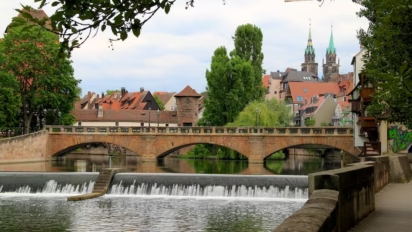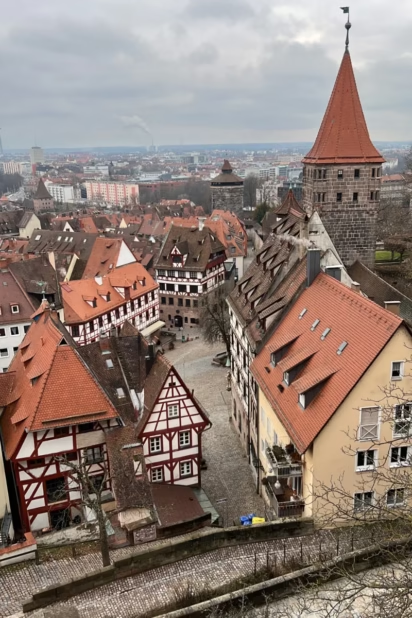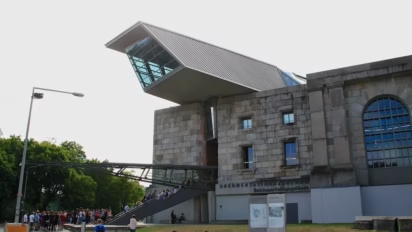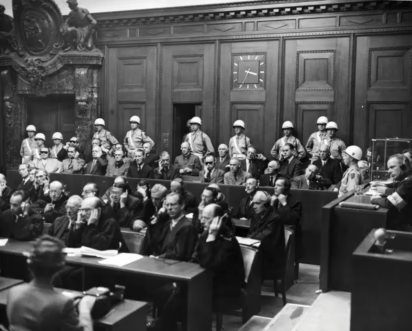The best sights to see in Nuremberg are the Imperial Castle (Kaiserburg), top museums, Gothic churches, a wall-enclosed old town, and sights associated with the Nazi party rallies and trials.
Nuremberg (Nürnberg) was a major power during the Middle Ages and despite extensive damage during the Second World War has many interesting and historical sights worth seeing. Uniquely for a German city of this size, the old town is still encircled by its defensive town wall. The Kaiserburg (Imperial Castle) was central to German power politics for centuries. Several Gothic churches are filled with art while the Albrecht Dürer house is a museum dedicated to the memory of this important German Renaissance artist. The Germanic National Museum has the largest collection of German art and cultural objects in the world. The Nazi Party Rally Grounds have the largest buildings surviving from the Nazi era while courtroom 600 used in the Nuremberg Trials may also be visited.
Nuremberg is the second largest city in Bavaria and also the unofficial capital of Franconia (Franken), the cultural rather than formal political or geographical area that includes most of northern Bavaria.
- Nuremberg is written Nürnberg in German and may also be written as Nuernberg.
Top Sights in the Old Town of Nuremberg in Franconia
Original medieval town walls still encircle the old town center of Nuremberg. Nuremberg was a major city during the Middle Ages and the large old town required a wall of no less than 5 km (3 miles) long. The wall is mostly intact and 71 of the original 130 defensive towers survived to the present.
Nuremberg’s old town is cut into two by the Pegnitz River. The part to the south and closest to the Hauptbahnhof (Main Station) and the Germanic National Museum (Germanisches Nationalmuseum) is called Lorenz while the northern section where the Imperial Castle (Kaiserburg) and Albrecht Dürer House are located is known as Sebald.
Visit the Nürnberger Kaiserburg (Imperial Castle)

The impressive Kaiserburg (Imperial Castle), located on a hill in the far northwestern corner of Nuremberg’s old town, is the symbol and defining architectural feature of Nuremberg’s skyline. The Kaiserburg fortress was only used when the Holy Roman Emperor of the German Nation was in town.
Throughout the Middle Ages, Nuremberg so many imperial visits. Between 1050 and 1571, every Holy Roman emperor visited Nuremberg at least once. Over 300 imperial visits took place with Kaiser Karl IV visiting Nuremberg around 40 times while Ludwig the Bavarian came 70 times.
Top Sights in Nuremberg’s Sebald Old Town
Arguably the best-looking and most romantic square in Nuremberg is the Tiergärtnerplatz. This square is below the castle with medieval surroundings that include the Kaiserburg, town wall, an important town gate, and half-timbered buildings including the house of Albrecht Dürer.
The Albrecht-Dürer-Haus on the Tiergärtnerplatz is a museum in the house where German Renaissance artist Albrecht Dürer worked and lived for most of his life. Somewhat miraculously, the Dürer House survived the air raids of January 2, 1945, when 90% of Nuremberg’s old town was destroyed.
The large Hauptmarkt (Main Market) is the center of all celebrations and markets, including one of the largest and best-known Christmas markets in Germany. The lovely Gothic Schöner Brunnen fountain is a copy of a 14th-century masterpiece — bits of the original are in the Germanisches Nationalmuseum.
The Frauenkirche (Church of Our Lady) overlooking Hauptmarkt is a 14th-century Gothic hall church. The Männleinlaufen is a mechanical show on the main façade of the Frauenkirche. Daily at noon, seven men representing the Prince-Electors come out to pay homage to the Holy Roman Emperor. The symbolism — now of course dated and irrelevant — is probably more impressive than the actual show.
The nearby St Sebalduskirche is architecturally a more interesting church. The exterior of the Sebalduskirche in Nuremberg is an uneasy combination of the Romanesque and Gothic but the interior is much more harmonious.
Tours of the beer cellars and the art bunker, where Nuremberg’s art was hidden during the Second World War, are popular but only moderately interesting. The sights above ground are far more interesting.
Top Sights in the Lorenz Area of Nuremberg
The Lorenz Area of Nuremberg houses several museums – see below. Further important sights here include the St Lorenzkirche, a High Gothic church that was mostly rebuilt after 1945. The impressive art in the Lorenzkirche is original.
A medieval-look area was recreated near the tower gate at the Main Station. The Handwerkerhof has arts and craft shops as well as restaurants recalling the lure of yesteryear.
Top Museums in Nuremberg

Nürnberg has several major museums of which the Germanic National Museum is by far the most important. The Germanische Nationalmuseum has the largest collection of German art and cultural objects in the world.
The Verkehrsmuseum (Transportation Museum) in Nuremberg includes the Communication Museum as well as the DB German Railways Museum, which is very popular with especially children as it houses the largest collection of historical railway equipment in Germany.
The Neues (New) Museum has an impressive collection of modern art and design objects showing that Nuremberg is not only about the Middle Ages and faded imperial grandeur.
Nuremberg has been a major center of toy manufacturing. The Spielzeugmuseum (Toys Museum) has a large collection of toys. The displays are aimed at adults – no touching, please! (The Germanische Nationalmuseum also has a significant toys exhibition.)
Nazi Party-Related Sights in Nuremberg
Nuremberg played a large role in the history of the Nazi Party and several sights here are worth seeing.
The Nazi Party Rallying Grounds in Nuremberg
Nuremberg’s central location in the heart of Germany, and (originally) to a lesser extent its imperial past, made it the location of choice for the infamous Nazi Party rallies of the 1920s and 1930s. Large Nazi-era monumental structures to the south of the old town include:
- The Kongreßhalle (Congress Hall), which was to have seated 50,000, with a very interesting Documentation Center. (Only a small temporary exhibition is open until at least 2025.)
- The ceremonial Große Straße (Great Road), a 2 km (1.2 mile) long road built with 60,000 slabs of granite (using mostly slave labor).
- The Zeppelin Tribune from where Hitler addressed the rallies.
Visit the Nuremberg Trials Memorial to See Courtroom 600
Probably the internationally most famous event in Nuremberg’s history was the post-Second World War trials of top Nazi leaders. The International Military Tribunal – better known as the Nuremberg Trials – sat in the Nürnberg-Fürth courthouse in Schwurgerichtssaal 600. The Nuremberg Trials Memorial is easily reached on U-Bahn U1.
Nuremberg’s central geographical location played a major role in its history and up to the present ensures excellent transportation links to the rest of Germany and Europe. Cheap flights to Nuremberg are available from many German and European airports as Nürnberg Airport (NUE) is a major hub of German low-cost airline Air Berlin. Nuremberg is also a major railway hub with frequent trains to Frankfurt am Main and Frankfurt International Airport (FRA) taking two hours while Munich (München) is only an hour by train.
See also Top Nazi Party Sights in Nuremberg for more on the sights associated with the Third Reich.
Nürnberg City Card: Save on Sightseeing in Nuremberg
Two discount deals are worth considering to save on sightseeing when visiting Nuremberg (Nürnberg):

A day ticket valid for admission to all Nuremberg city municipal museums is €10.50 and gives admission to the Albrecht-Dürer-Haus, Museum Tucherschloss und Hirsvogelsaal, Stadtmuseum Fembo-Haus, Spielzeugmuseum (Toys), Museum Industriekultur, Nuremberg Trial Memorial, and the Dokumentationszentrum Reichsparteigelände. It is available from all participating museums.
The Nürnberg City Card is around €33 and covers all public transportation in Nuremberg and Fürth for 48 hours. It gives free admission to the Imperial Castle Nuremberg (Kaiserburg), Deutsches Museum Nuremberg, Germanisches Nationalmuseum, Albrecht Dürer House, Neues Museum, Toy Museum, Documentation Center Nazi Party Rally Grounds Interim Exhibit (main exhibition closed until 2025), Memorium Nuremberg Trials, DB Museum (German Railways Museum), Museum for Communication, Museum of Industrial Culture with the School Museum, City Museum at Fembo House Permanent Exhibit: A Crown – Power – History, Museum Tucher Mansion, Bavarian Bible Museum, Museum of Natural History, towerofthesenses, Kunsthalle Nuremberg, Kunstvilla Nuremberg, Kunsthaus Nuremberg, Museum Executioner’s House, Zoo Nuremberg, Children’s Museum, Red Cross Museum, Motor Museum Merk, Faber-Castell Stately Home with the Museum “Alte Mine”, Bratwurst Museum, Jewish Museum Franconia, Fürth, City Museum Fürth, and Ludwig Erhard Center Fürth. It also gives savings on guided tours and further events.
More on Traveling to Nürnberg:

More resources for planning travel to Nuremberg in Bavaria, Germany:
- Buy a Nürnberg City Card to save on sightseeing and transportation.
- Top Sights to See in Nuremberg:
- Visit the Nuremberg Trials Memorial (Courtroom 600)
- Reichsparteitagsgelände (Nazi Party Rally Grounds)
- Visit the Germanisches Nationalmuseum — the largest cultural history museum in Germany.
- Visit the Kaiserburg — Imperial Castle in Nuremberg
- Visit the Albrecht-Dürer-Haus Museum where the artist lived and worked for two decades.
- Visit the DB German Railways Museum
- Visit the Nuremberg Christmas Market (Nürnberger Christkindlesmarkt)
- Transportation to Nuremberg in Bavaria
- Traveling by Train to Nuremberg – German Railways Timetables to Nuremberg
- Book Flights on Lufthansa, KLM, or Air France.
- Cheap Flights to Nuremberg Airport (NUE)
- Transportation to Nuremberg Airport (NUE)
- Transportation from Munich Airport (MUC) to Nuremberg
- Nuremberg hotels are generally less pricey than those in Frankfurt or Munich.
- Adidas Factory Outlet Stores — half an hour north of Nuremberg but a very popular stop en route to Bamberg.
- Suntransfers give online quotations without requiring flight and personal details.




